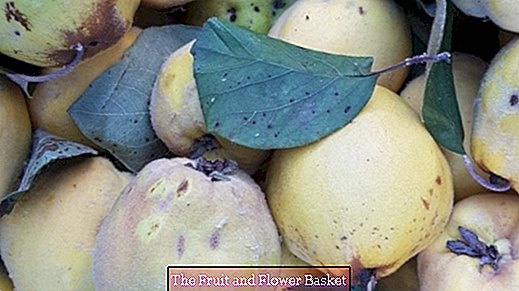8 facts about quinces
Sweet and savory recipes with quince find their way into our kitchen. As a remedy, the quince is good for the intestines or for colds. But before processing is the right harvesting and storage.
The quince is on the rise. It can do much more than just jelly, juice or compote. Whether you have one or more quince trees to harvest or quinces from neighbor's garden may bring, maybe a few tips about the quince will help you.
1. Quinces are not to bite
Raw quinces are not poisonous. But they are also not suitable for biting. Even if they look pretty on the tree or smell well stored: they are hard, woody and bitter. Only through further processing, e.g. By cooking, steaming or roasting, they soften, lose their bitterness and develop their taste. This applies at least to our Central European quince varieties. A few of the world's 200 quince varieties can also be eaten raw.
2. Do not let quinces fall in frost
Custard Quinces you recognize by their color and the lessening of the fluff. If the color changes from green to golden yellow and the shell has little or no fluff, then the time has come: from the tree. The period is between the end of September and November, usually in the first half of October. If frosty nights are announced before your planned harvest, then you should also pick and store the unripe fruits. They ripen in the next few weeks. A little ground frost in the early morning hours does not hurt in my experience.
3. Store quinces separately and cool
The quince aroma quickly spreads to other fruit varieties. To avoid this, keep the distance and store the quinces separately. In the cool cellar the quinces hold you for about 6 to 8 weeks, at 0 to + 2 ° C maybe a bit longer. If you do not have a cellar or the quinces are battered, then get to work quickly before the quinces lose their aroma or become lazy and muddy. If necessary, you can also keep them in the fridge for a week. Also in the refrigerator tolerate e.g. Apples and pears not with the quince. But you the gas from ethylene, let the quince so mature faster and thus spoil.
I can give you the all-clear if the pulp inside brown, the quince is otherwise okay. Then you can still use the quinces.
4. Recipes with quince
The quince has again found its way into the recipe landscape. In my youth, we had the basic recipes for jelly or compote, jam, quince bread or juice. The liqueur was spiced with it (as a more or less popular souvenir). Today traditional recipes are reissued and refined. This is cooked, fried or baked. Sweet sweets and biscuits are enriched with quince, crumbles with butter sprinkles served, fruity chutneys with a sharp or sour note. The quince is also found in soups, together with pumpkin or potato. Even in cabbage or lamb salad their aromatic note is announced.
5. The fluff must go
Before you start processing your quinces? the oily fluff must definitely go away. With ripe quince the fluff should have formed back. However, if the quince are harvested before ripening or stored with maturation, then remove the fluff and thus the bittering with the help of kitchen roll or kitchen crepe, a cloth or a brush.
6. Ingredients of the quince
The quince contains besides potassium, sodium, zinc, iron, copper, manganese and fluorine a lot of vitamin C. Further vitamins are present in smaller quantities. Because the quince is not eaten raw, but processed, most vitamins in the preparation will be flutes, unless the quinces are cooked gently in the pressure pot.
Quinces contain a lot of Piktin, a water-soluble plant fiber with swelling capacity. An advantage when cooking, because pectin is considered a natural binder. Significantly less gelling sugar needs to be used than with other types of fruit. Compared to other jellies and marmalades, this also means fewer calories. Furthermore, the high pectin content cleanses the intestine, binds bacterial toxins, bile acids and heavy metals and lowers the cholesterol.
7. Remedies from quince kernels
Quince kernels contain a large amount of mucilage. Quince mucus is good for sore throat and cough, as well as for gingivitis. For the quince slime, soak the kernels in some water and cook on low heat. Then you can gargle with the mucus or drink it. Likewise, you can apply the anti-inflammatory quince mucus externally with brittle skin, small burns or chapped lips.
Dried quince kernels are sucked like a cough drop. You should not chew the seeds, because then (toxic) hydrocyanic acid is released.
8. Quince as a fragrance dispenser
Even though I have space to store in my basement, I always turn some of the first quince off as a fragrance dispenser. In the processing with me also mostly shells remain, which I dried my (admitted, bought) tea herbal mixtures amish or place on the living room ledge.If you have come to the taste or want to come and have no quince tree, maybe there is a tree in the neighborhood of old stock. Not everyone has the time and energy to harvest and process, and may be happy about your interest in the quince.





